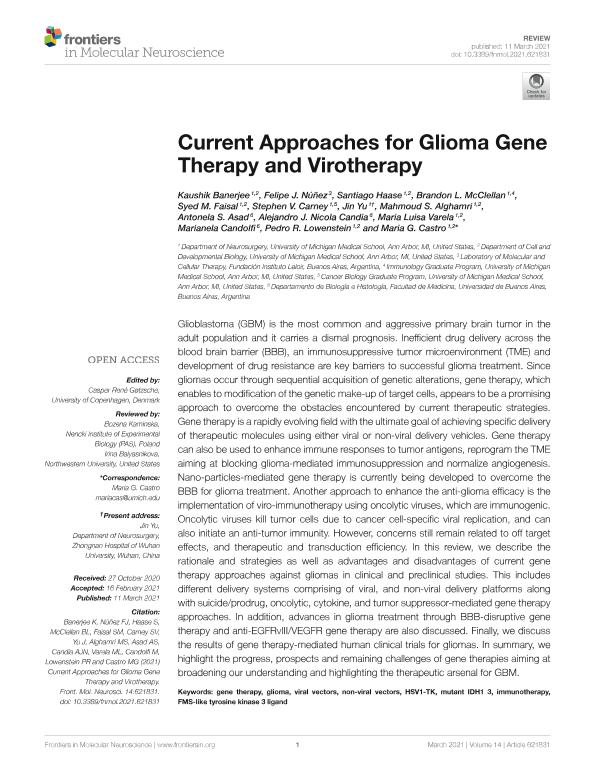Artículo
Current Approaches for Glioma Gene Therapy and Virotherapy
Banerjee, Kaushik; Núñez Aguilera, Felipe Javier; Haase, Santiago; McClellan, Brandon L.; Faisal, Syed M.; Carney, Stephen V.; Yu, Jin; Alghamri, Mahmoud S.; Asad, Antonela Sofía ; Nicola Candia, Alejandro Javier
; Nicola Candia, Alejandro Javier ; Varela, Maria Luisa; Candolfi, Marianela
; Varela, Maria Luisa; Candolfi, Marianela ; Lowenstein, Pedro R.; Castro, Maria G.
; Lowenstein, Pedro R.; Castro, Maria G.
 ; Nicola Candia, Alejandro Javier
; Nicola Candia, Alejandro Javier ; Varela, Maria Luisa; Candolfi, Marianela
; Varela, Maria Luisa; Candolfi, Marianela ; Lowenstein, Pedro R.; Castro, Maria G.
; Lowenstein, Pedro R.; Castro, Maria G.
Fecha de publicación:
03/2021
Editorial:
Frontiers Media
Revista:
Frontiers in Molecular Neuroscience
ISSN:
1662-5099
Idioma:
Inglés
Tipo de recurso:
Artículo publicado
Clasificación temática:
Resumen
Glioblastoma (GBM) is the most common and aggressive primary brain tumor in the adult population and it carries a dismal prognosis. Inefficient drug delivery across the blood brain barrier (BBB), an immunosuppressive tumor microenvironment (TME) and development of drug resistance are key barriers to successful glioma treatment. Since gliomas occur through sequential acquisition of genetic alterations, gene therapy, which enables to modification of the genetic make-up of target cells, appears to be a promising approach to overcome the obstacles encountered by current therapeutic strategies. Gene therapy is a rapidly evolving field with the ultimate goal of achieving specific delivery of therapeutic molecules using either viral or non-viral delivery vehicles. Gene therapy can also be used to enhance immune responses to tumor antigens, reprogram the TME aiming at blocking glioma-mediated immunosuppression and normalize angiogenesis. Nano-particles-mediated gene therapy is currently being developed to overcome the BBB for glioma treatment. Another approach to enhance the anti-glioma efficacy is the implementation of viro-immunotherapy using oncolytic viruses, which are immunogenic. Oncolytic viruses kill tumor cells due to cancer cell-specific viral replication, and can also initiate an anti-tumor immunity. However, concerns still remain related to off target effects, and therapeutic and transduction efficiency. In this review, we describe the rationale and strategies as well as advantages and disadvantages of current gene therapy approaches against gliomas in clinical and preclinical studies. This includes different delivery systems comprising of viral, and non-viral delivery platforms along with suicide/prodrug, oncolytic, cytokine, and tumor suppressor-mediated gene therapy approaches. In addition, advances in glioma treatment through BBB-disruptive gene therapy and anti-EGFRvIII/VEGFR gene therapy are also discussed. Finally, we discuss the results of gene therapy-mediated human clinical trials for gliomas. In summary, we highlight the progress, prospects and remaining challenges of gene therapies aiming at broadening our understanding and highlighting the therapeutic arsenal for GBM.
Archivos asociados
Licencia
Identificadores
Colecciones
Articulos(INBIOMED)
Articulos de INSTITUTO DE INVESTIGACIONES BIOMEDICAS
Articulos de INSTITUTO DE INVESTIGACIONES BIOMEDICAS
Citación
Banerjee, Kaushik; Núñez Aguilera, Felipe Javier; Haase, Santiago; McClellan, Brandon L.; Faisal, Syed M.; et al.; Current Approaches for Glioma Gene Therapy and Virotherapy; Frontiers Media; Frontiers in Molecular Neuroscience; 14; 3-2021; 1-30
Compartir
Altmétricas



